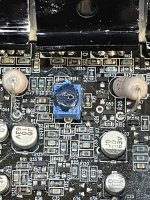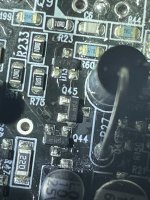Hi all,
I have a p600x4 that keeps blowing the mosfets on the right rear channel. Both npn and pnp.
It has also taken out the collector .5 ohm surface mount resistor 2 times.
I have replaced all of the parts only for it to randomly fail on the same channel again.
It can last 5 minutes or a week before failing again. I am at a loss. Please help
Thanks in advance
I have a p600x4 that keeps blowing the mosfets on the right rear channel. Both npn and pnp.
It has also taken out the collector .5 ohm surface mount resistor 2 times.
I have replaced all of the parts only for it to randomly fail on the same channel again.
It can last 5 minutes or a week before failing again. I am at a loss. Please help
Thanks in advance
hello Perry,
Thank you for the reply. I have not measured idle current, I have only replaced parts.
The amp will work for an unknown amount of time at high and low levels. Until it decides not to and goes into protect at which point the fets on the right rear short.
Volume doesn’t seem to matter. I will say though that I have noticed it usually happens shortly after first time turning it on. If I make it past a period of time it seems to be ok for that day. Reliability is not good and it’s always the same channel.
No schematic seems to be available yet
Thank you for the reply. I have not measured idle current, I have only replaced parts.
The amp will work for an unknown amount of time at high and low levels. Until it decides not to and goes into protect at which point the fets on the right rear short.
Volume doesn’t seem to matter. I will say though that I have noticed it usually happens shortly after first time turning it on. If I make it past a period of time it seems to be ok for that day. Reliability is not good and it’s always the same channel.
No schematic seems to be available yet
I have not . Should I compare the other channels ? as I don’t have specs for idle current.
Also just curious. Is it necessary after replacing fets? I’m wondering why that channel would go in the first place. It was playing quietly. Just curious on your thoughts.
Also just curious. Is it necessary after replacing fets? I’m wondering why that channel would go in the first place. It was playing quietly. Just curious on your thoughts.
I can't say why it failed. It could be anything from a bad connection to a random component failure but you have to reset the bias any time you repair a channel in an amp.
If you have an amp meter on your 12v power supply, start with the bias control fully CCW then rotate it until you just see an increase in current draw from the 12v supply.
If no amp meter, set the bias to 1mv across the 0.1 ohm source resistors.
If the amp will power up without failing immediately, you should measure the voltage across those resistors to see where it's at.
Do you have an amp meter?
If you have an amp meter on your 12v power supply, start with the bias control fully CCW then rotate it until you just see an increase in current draw from the 12v supply.
If no amp meter, set the bias to 1mv across the 0.1 ohm source resistors.
If the amp will power up without failing immediately, you should measure the voltage across those resistors to see where it's at.
Do you have an amp meter?
I don’t have one on my power supply, but I do have one built into my multi meter.
I can put it in Series and check. I will try tonight.
It never fails at start-up. It could run for quite a while potentially. But the same channel will go.
I can put it in Series and check. I will try tonight.
It never fails at start-up. It could run for quite a while potentially. But the same channel will go.
Multimeters can be damaged by excessive current and Fluke meter fuses are expensive. Insert a 10-15 amp fuse in the B+ line to help protect the amp and measure the DC voltage across the 0.1 ohm source resistors at idle (no load, no signal). Post the exact meter reading (all digits displayed).
Hi Perry,
Here are the results of the fosgate p600x4
I am always able to power it up after the repair so I just took a chance.
All measurements are across the 0.1 ohm resistors.
Left front
1.2mv
1.2mv
Right front
.9mv
.7mv
Left rear ( bad channel that fails randomly)
.2mv
.2mv
Right rear
1.2mv
1.0mv
Total idle current warm
1.84 amps
Here are the results of the fosgate p600x4
I am always able to power it up after the repair so I just took a chance.
All measurements are across the 0.1 ohm resistors.
Left front
1.2mv
1.2mv
Right front
.9mv
.7mv
Left rear ( bad channel that fails randomly)
.2mv
.2mv
Right rear
1.2mv
1.0mv
Total idle current warm
1.84 amps
Squeeze it gently with a pair of pliers, from various angles, and it generally pops off.
While your meter is connected across one of the source resistors in the bad channel, push on various parts of the board with a non-conductive probe (the handle of a screwdriver is good enough) to see if the reading changes.
The bias being lower isn't a problem (unless, possibly, it's causing the output to oscillate). I was expecting it to be higher than the rest. That said, before the amp goes back into service, the bias needs to be set.
While your meter is connected across one of the source resistors in the bad channel, push on various parts of the board with a non-conductive probe (the handle of a screwdriver is good enough) to see if the reading changes.
The bias being lower isn't a problem (unless, possibly, it's causing the output to oscillate). I was expecting it to be higher than the rest. That said, before the amp goes back into service, the bias needs to be set.
I would try connecting the outputs to different loudspeakers. Just swap the bad output with a good one. The imaging will be wrong for a while. If the same output fails the problem is in the amplifier. If a new output fails, look at the loudspeaker and the wiring. The tinsel on the loudspeaker could be shorting or a pinched wire could be grounded.
Simon7000,
Thanks that is the first thing I did after the issue with the same results. Wiring as well
Thanks that is the first thing I did after the issue with the same results. Wiring as well
Hi Perry,
I just set the bias to 1.0mv and 1.2 respectively on the bad channel. I press all around the board to look for change to no avail. Could it be a jumpy pot causing the issue? I don’t know what else it could be
I just set the bias to 1.0mv and 1.2 respectively on the bad channel. I press all around the board to look for change to no avail. Could it be a jumpy pot causing the issue? I don’t know what else it could be
It could be a bad pot. It's relatively rare but it happens.
Do you have a blow-dryer or heat gun and a can of compressed air (the stuff to clean keyboards and such)?
Do you have a blow-dryer or heat gun and a can of compressed air (the stuff to clean keyboards and such)?
OK. Where are the bias transistors in this amp? They should be near the output transistors and marked RO if they're surface mount transistors.
I did trace the output gate back to the push pull transistor’s last night. I don’t see anything with RO but it does lead back to q44 and q45 for this example.
Btw I lightly put heat from my heat gun in the area of the pot and the bias voltage dropped from 1.1 to .3 real fast
Btw I lightly put heat from my heat gun in the area of the pot and the bias voltage dropped from 1.1 to .3 real fast
Attachments
The base of the bias transistor is typically directly connected to the center terminal of the bias pot. See if that helps.
After you find that transistor, you will need to have all transistors tightly clamped to the heatsink before we do anything else.
After you find that transistor, you will need to have all transistors tightly clamped to the heatsink before we do anything else.
Last edited:
- Home
- General Interest
- Car Audio
- P600x4 keep blowing same channel

